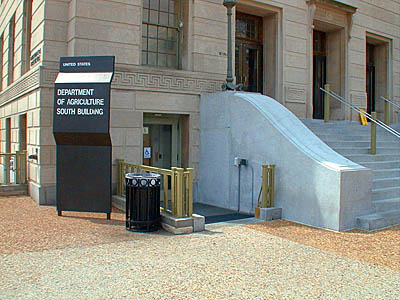Accessible routes in a multi-story tenant space
Posted on - Friday, January 4th, 2019
Accessible routes#ADAFact
The accessible route for people with disabilities must be located so it coincides with the route that everyone else will be taking.
This is the basic tenet of the ADA is for equal access. The scoping lets us know:
206.3 Location. Accessible routes shall coincide with or be located in the same area as general circulation paths. Where circulation paths are interior, required accessible routes shall also be interior
In other words, if a route is through the front door, and the front door is not accessible, we are not allowed to make someone in a wheelchair go to the back door to enter the building.
|
Accessible route in a multi-tenant spaceThe second part of the statement tells us that if the general route is on the interior, the accessible route must also be on the interior. This means that if we have a two-story space with an interior stair, the accessible route should also be on the interior of the space. The ADA has a requirement when providing a new stair in a space:
206.2.3.1 Stairs and Escalators in Existing Buildings. In alterations and additions, where an escalator or stair is provided where none existed previously and major structural modifications are necessary for the installation, an accessible route shall be provided between the levels served by the escalator or stair unless exempted by 206.2.3 Exceptions 1 through 7.
This means that if you have two levels that were not connected together at the time of new construction, but they will be connecting by adding a stair as part of an alteration, then an accessible route connecting the two floors (and located in the same area) will have to be provided.
So If there is an office building with a tenant that would like to lease two floors and connect them with an internal stair, they would be required to also provide an elevator or a ramp connecting the stories. If the building already had an elevator in the core, this would not be able to be used since the elevator is outside the tenant space. The new elevator would have to be located within the tenant space.
The exception mentioned in the last sentence of the standard describes some buildings that are not required to connect the floors together even if there is a new stair provided. Read my past newsletter about the elevator exception here
|
TDLR Technical MemoThe Texas Department of Licensing and regulation issued a technical memo that explains their position on this issue.
|
What if we can’t make a building comply?#ADAfact
If it is technically infeasible or not readily achievable to provide access to persons who use wheelchairs, we are still required to provide accessible elements to people with other disabilities such as persons who are visually impaired, or hearing impaired or other mobility challenged who use a walker, crutches and other devices
|
 Abadi
Abadi 






